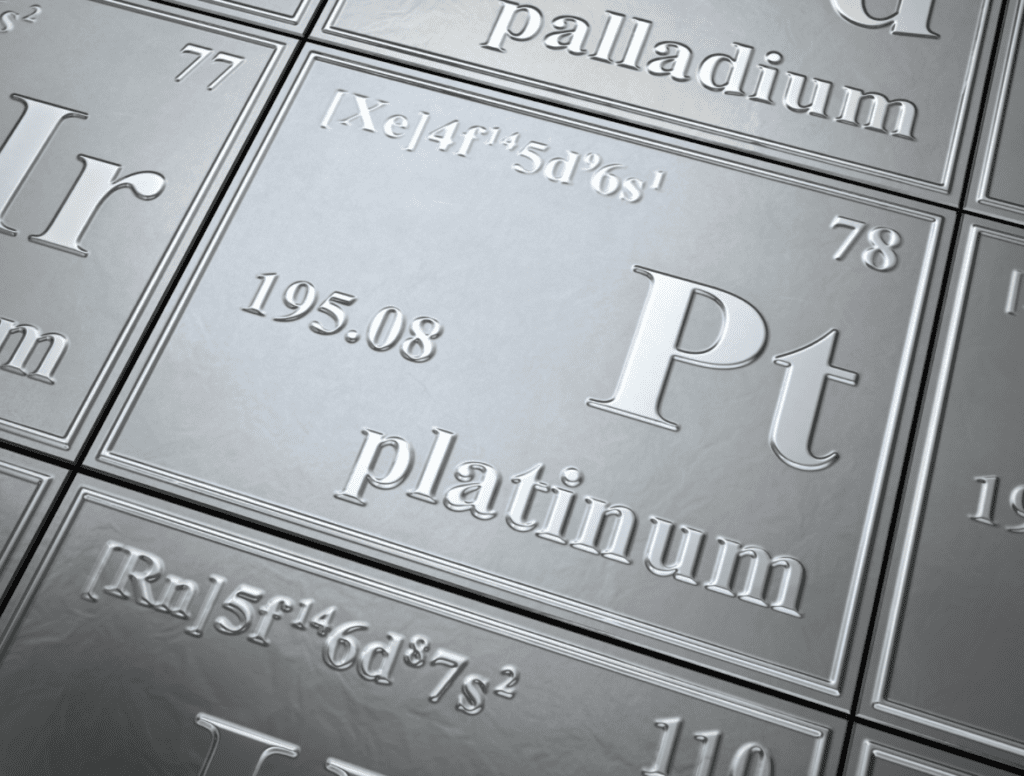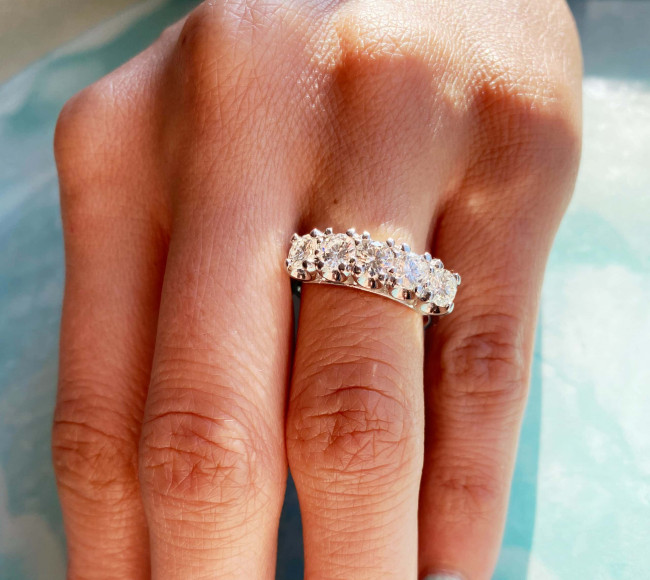
Table of Contents
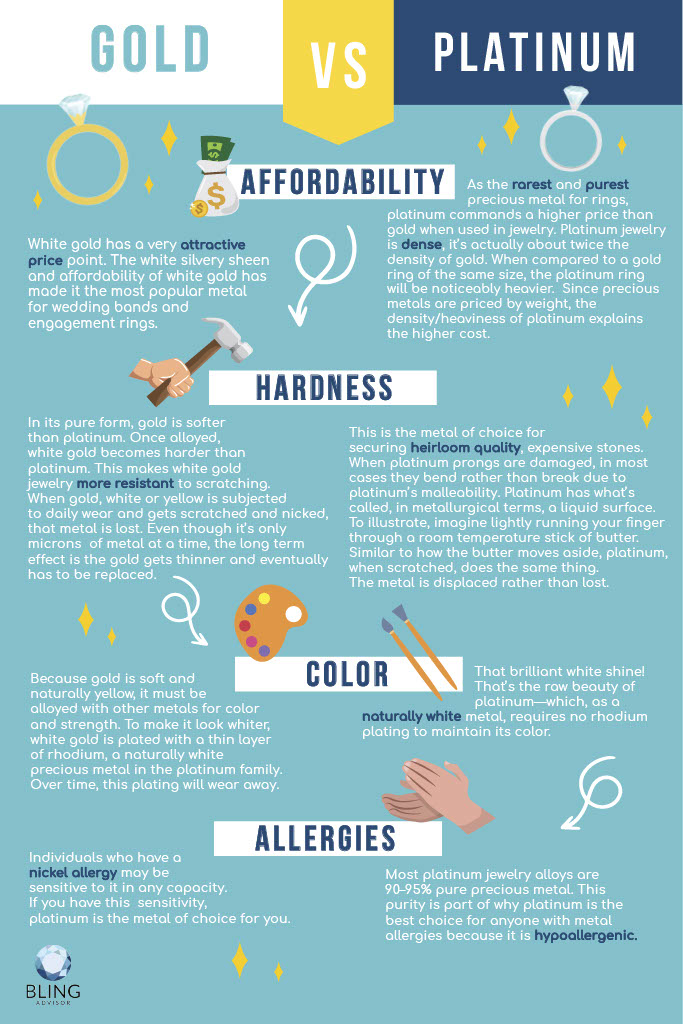
Platinum vs Gold Jewelry: What Are The Biggest Differences?
Platinum vs Gold
When deciding between different types of metals, the decision can be a difficult one, particularly if you’re purchasing an important piece such as a wedding or engagement ring. Many people are torn between gold and platinum when making a decision. The differences between the two metals may seem minimal, but there are actually some quite significant differences between gold and platinum that should be noted.
Platinum vs Gold Jewelry: Differences in Color
It can actually be very difficult to spot the color differences between platinum and white gold. Platinum is often considered the best metal for jewelry such as wedding rings and engagement rings, but when it comes to appearance, white gold and platinum can be nearly identical. One major difference between platinum and gold is the finish: platinum is only available in a silvery finish, whereas gold can be yellow, rose, white, and other colors. Additionally, the color of gold can actually change slightly depending on the karat quality, so there are plenty of different choices. Platinum certainly has fewer available color options than gold does, but for those who like the silvery finish, platinum is a great choice.
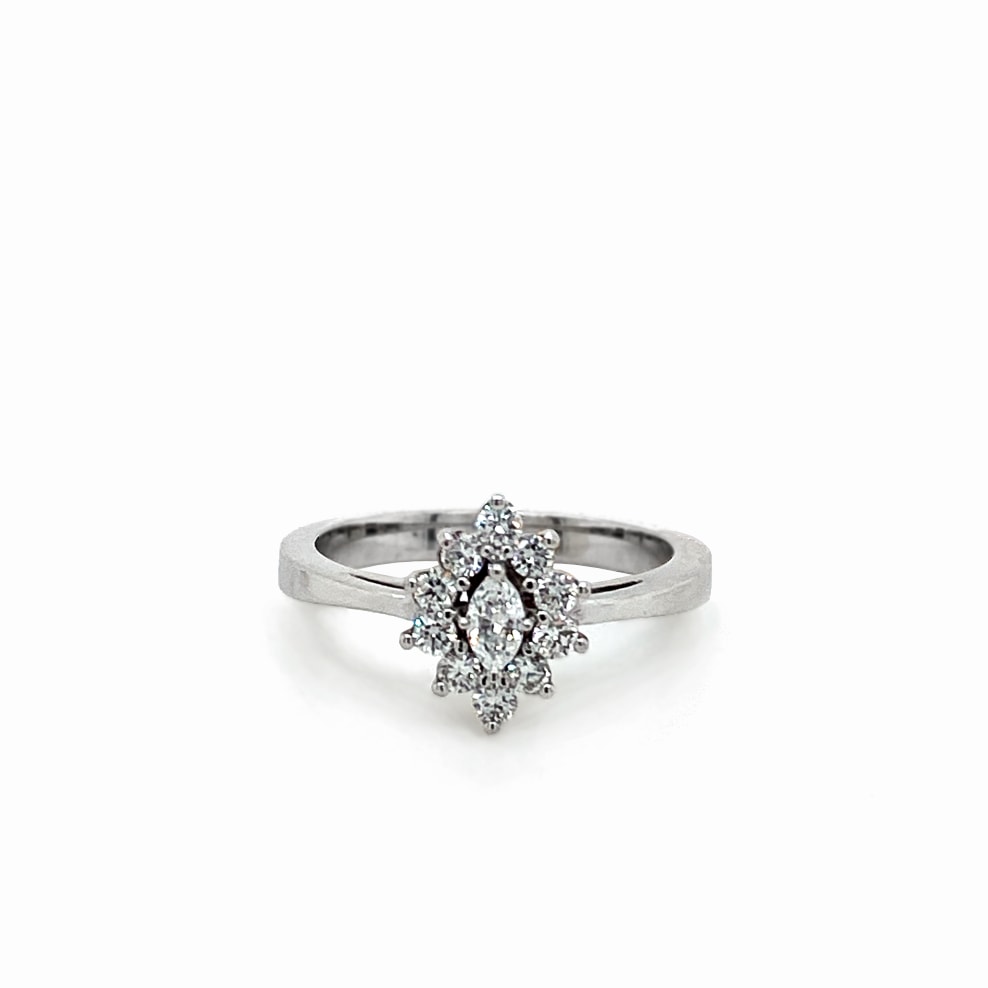
Marquise Halo Engagement Ring
This diamond halo fashion ring is sure to turn heads. The center marquise diamond engagement ring is surrounded by a halo of 10 round diamonds, making it sparkle and shine. It’s set in white gold and would look great on any finger.
What Are Platinum and Gold Made from?
Platinum and some types of white gold might look similar, but the composition of platinum and gold is actually very different. As far as purity is concerned, platinum rings have an average content of 90-95% platinum, which provides a much greater level of strength than gold. An 18k gold ring band, on the other hand, is 75% gold, so the price difference can be attributed to the number of other rare metals required, as 25% is another alloy. The composition of 14 karat gold is 58.3% gold and 41.7% other alloys.
Interestingly, gold jewelry that is made out of sterling silver, palladium, or copper tends to last longer than jewelry that is made of pure 24 karat gold. So, in many cases, it might be better to opt for gold that isn’t 24 karat. Additionally, the color of gold can vary a lot depending on the other types of alloys used. So, some people may find that they prefer a certain type of gold alloy due to color differences.
Due to its natural density, platinum can be used for fine jewelry to make 95% platinum and only 5% silver-toned alloys, such as iridium, ruthenium, or cobalt.
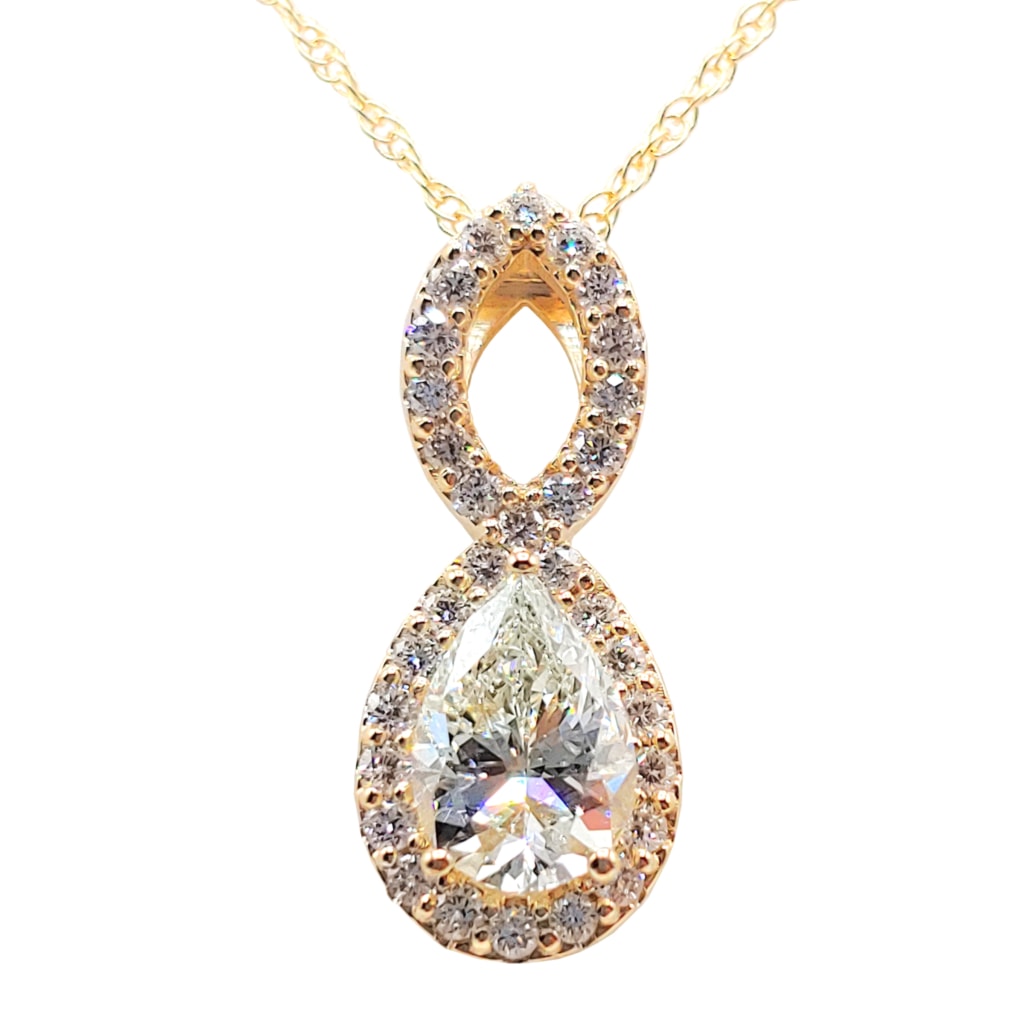
Diamond Infinity Pendant & Gold Necklace
The Bling Advisor necklace is the perfect way to show off your sophisticated sense of style. The beautiful pear-shaped diamond at the center is sure to captivate everyone’s attention, while the 31 accent diamonds add a touch of glamour and elegance.
Or would you prefer to create your own piece of jewelry?
Durability
Durability is a very important factor to consider when it comes to choosing jewelry. Of course, this is particularly true for jewelry such as wedding or engagement rings. Any jewelry that is going to be worn regularly and needs to last for a long time should be made of the most durable metals possible. But what determines the durability of different metals? And what are the differences in durability between gold and platinum? Well, the durability of precious metals is determined by two primary factors:
· Abrasion, scratching, and surface wear are indicators of hardness.
· The malleability of a material refers to how easily it can be bent and shaped. Malleability will make a certain metal less rigid/less brittle and more prone to bending.
Both metals have advantages and disadvantages when it comes to durability. A fine jewelry setting holding a precious gemstone should be safe, secure, and durable. The fact that platinum is a soft metal makes it more susceptible to scratches, despite being stronger and more durable than gold. In metallurgical terms, platinum jewelry scratches more easily as it has a very fluid surface. Jewelers can also bend and work with gold because it’s more malleable than platinum. Platinum also has a lower tendency to bend, which makes it a little safer for setting gemstones. However, scratches and some wear and tear aren’t always a bad thing. Many people actually like the antique look or patina of platinum jewelry with scratches along the surface.
Platinum rings are not the only jewelry that deteriorates with wear; white gold jewelry will slowly revert to its original yellow hue. In spite of some of the durability issues associated with both materials, you should not rule out choosing either of these metals. Most jewelers will provide cleanings or care options for your gold or platinum jewelry to keep it looking as good as new.

Two Carat Diamond Earrings set in 14k White Gold
If you’re looking for a little bit of everything, our Bling Advisor earrings are perfect! With 2.00 carats of diamonds, these earrings are sure to make a statement. You have the choice between friction, guardian or screw backs – we even offer them in rose and yellow gold at no additional cost!
What About People with Metal Allergies?
As a hypoallergenic metal, platinum offers several advantages over gold for those with allergies, one of which is the absence of nickel, which may cause allergic reactions in some people. The skin around some gold jewelry can be irritated by nickel. When purchasing any jewelry for yourself or someone else with a metal allergy, it’s certainly a bit safer to go with platinum.
Allergy potential is significantly reduced with platinum since it contains fewer alloys. Copper, nickel, and zinc are all metals found in yellow, rose, and white, which make the colors sensitive to those with metal allergies. As a rule, white gold does not pose this risk, as it is usually coated with rhodium, which acts as a barrier and prevents most skin sensitivities.
Which is More Expensive, Gold or Platinum?
Platinum is usually the more expensive choice when choosing a metal. Platinum is so highly priced because it is denser than gold, which means it will weigh more than gold. Due to its rarity and strength, platinum is more expensive, especially in Russia and South Africa, where it is thirty times rarer than gold.
Gold is also more alloyed than platinum, which is denser and purer. For example, an 18-karat white gold ring only contains 75% gold, while a platinum ring contains 95% platinum – that means more precious metal for the same setting. Furthermore, platinum requires more skill, tools, and time for jewelers to work with. This also adds to the expense associated with platinum, as you’re paying for the intricate and skilled work of the jeweler. The same setting in platinum will cost approximately 20-30% more than the same setting in white gold.
Are There Differences in Weight?
Platinum is approximately 11% heavier than 24 karat gold. Of course, this is one of the big reasons why platinum is so expensive, as we already discussed. But while weight makes the platinum cost more, it also has some disadvantages. Platinum jewelry can be a little more uncomfortable to some because of its weight. This can be off-putting for some, particularly when shopping for a wedding or engagement ring. If you plan to wear jewelry very often, or even every day, it can be more tempting to go for a lighter-weight option. For this reason, gold might be considered the better option for those who want to wear a ring or piece of jewelry that feels light and airy and is easy to forget that you’re wearing.
Which Metal is Rarer?
Of course, rarity is another reason why platinum is so expensive. Platinum is much rarer than gold, which lends to its high price tag! The production of gold each year is approximately 1,500 tonnes, as opposed to the production of platinum at 160 tonnes. Basically, gold is about 30 times more common than platinum, so if you are someone who likes the idea of wearing a rare piece, platinum might be your dream metal.
Are There Differences in the Finish?
The finish does have some impact on the overall look of jewelry. Even though platinum and white gold look very similar in appearance, platinum has a more satin-like finish than white gold, which is slightly shinier. This difference is usually very subtle and isn’t even typically noticeable to the untrained eye. What you prefer is purely a matter of personal preference.
What About Care and Cleaning?
Jewelry needs to be looked after and maintained in order to last as long as possible, and look good, of course! Regular polishing and cleaning are important for both platinum and gold. The finish of platinum can become matte and scratched over time, and it needs to be polished to maintain its luster. Depending on one’s personal preference, platinum might develop a worn patina over time. Some people like the way that a patina or some wear and tear look on jewelry, so this isn’t necessarily an issue for everyone. But it does mean that some people are happy to go a little longer between cleanings!
Similarly, to keep its gleaming, glistening appearance, gold needs to be regularly polished. Gold can become quite easily scratched over time, so proper care is just as important as with any other metal. You should have your ring serviced yearly and rhodium should be applied to white gold to maintain its lustrous brightness and finish. This isn’t very expensive and can really have a positive effect on the appearance of white gold, so plating shouldn’t be overlooked. Platinum, on the other hand, retains its color without plating, so you can skip the regular replating process. Plating is also not required for yellow gold or rose gold – only polishing and cleaning are needed for their regular care rituals.
It’s important not to skip out on proper care and cleaning of your jewelry, no matter what metal you choose. Your jeweler should be able to recommend a proper care routine that will keep your jewelry looking beautiful for as long as possible. After all, you’ve spent a lot of money, so you should take pride in looking after your jewelry.
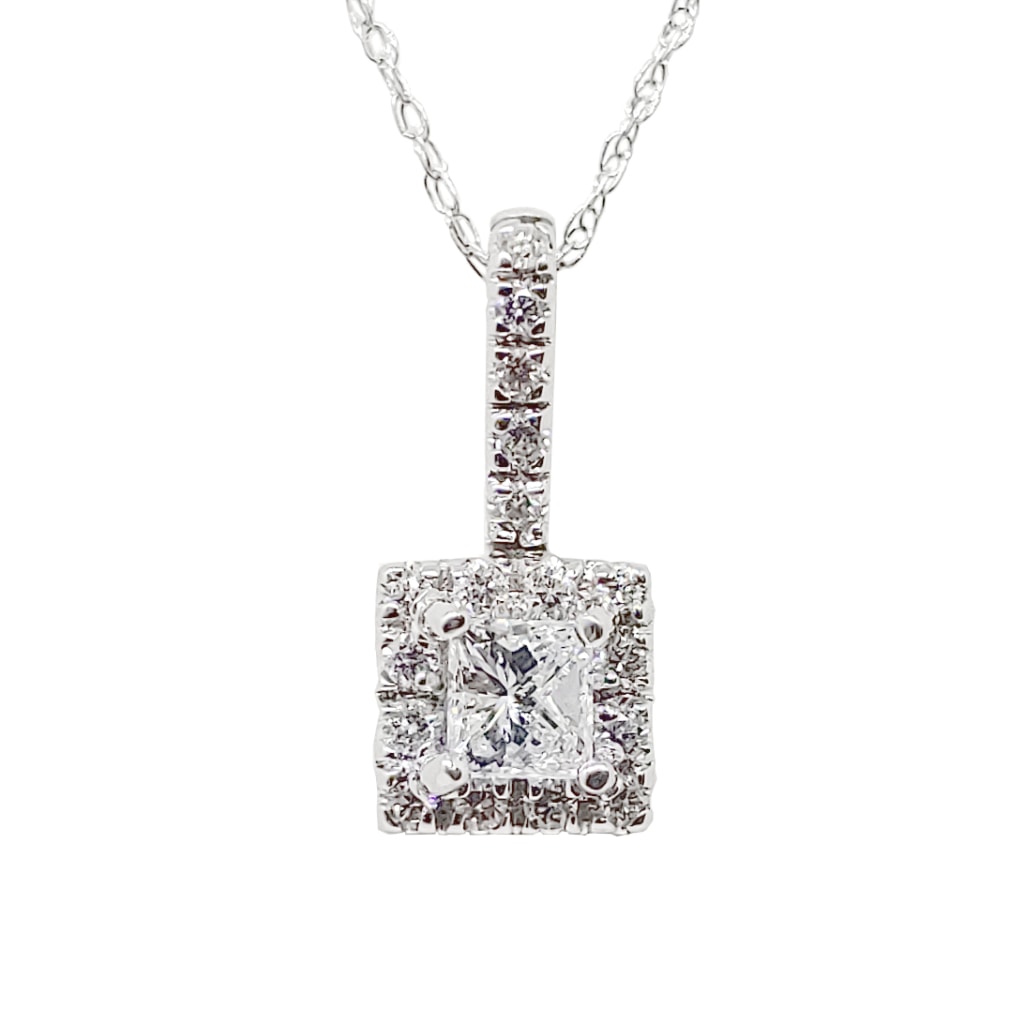
Halo Diamond Necklace
Get the ultimate sparkle with this gorgeous Halo Diamond Necklace. A stunning, center princess cut diamond that weighs .34ct captures everyone’s attention and is accompanied by an additional 19 accent diamonds weighing .17ct that really bring out its alluring shine. With H-I color and I-1 clarity, this piece of jewelry will turn heads as soon as you walk in the room and shimmer beneath whatever look you choose to wear. True to its grandeur and craftsmanship, this Halo Diamond Necklace is set in white gold with an 18-inch 14k white gold cable chain for added support. It’s a must-have for any wardrobe.
Key Takeaways
As you can see, there are a number of advantages and disadvantages to both gold and platinum. Some people are very particular about their jewelry choices, so knowing the differences between the two can be important when making a decision. Moreover, jewelry can be very expensive, so you should have all the knowledge that you need to make a proper and informed decision before spending your money. So, what are some of the most important key takeaways that you should know about the differences between gold and platinum?
- Visually, a platinum ring is the same as a white gold ring because they do not appear different from each other. When placed side by side, both platinum, and white gold will appear brilliant, white, and shiny.
- Pure gold is 24 karat and has a yellowish color.
- Metal allergies are commonly associated with the alloys mixed into gold (mainly nickel). For people who have metal allergies, platinum is the best choice.
- Platinum costs more than gold. Platinum engagement rings typically cost $800 – $1200 more than their white or yellow gold counterparts. Platinum is denser than gold, which may explain the difference in price. Platinum rings are 60% heavier than the same ring made out of 14k white gold.
- The naturally yellow nature of gold requires it to be maintained more than platinum, a naturally white metal. It is recommended that you rhodium plate white gold rings every 6-12 months or so in order to maintain their whiteness and their luster.
Both gold and platinum are beautiful choices when it comes to different metals used for making stunning jewelry. At the end of the day, the type of metal chosen comes down to personal preference. For example, some people may have to fork out on platinum jewelry due to allergies, while others might prefer the look of yellow or rose gold and so won’t opt for platinum. Either way, go with the option that you feel is right for your own personal style and preference.
